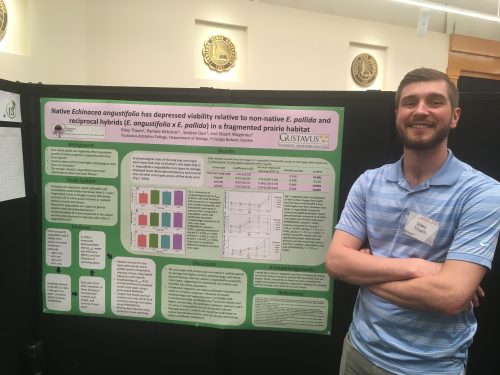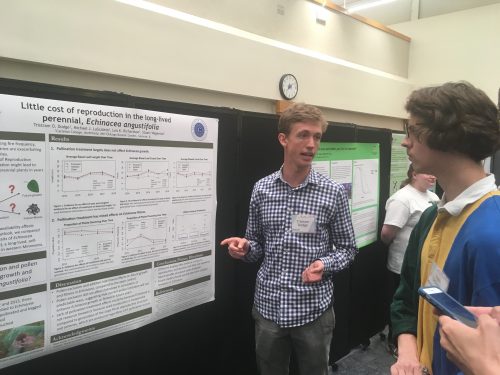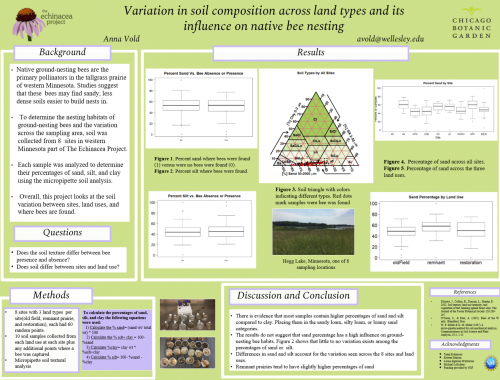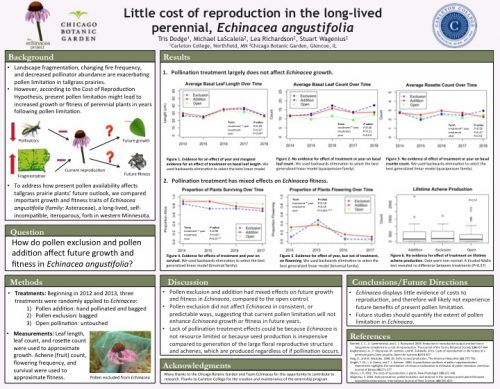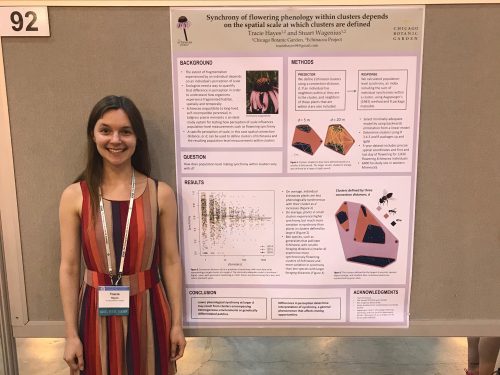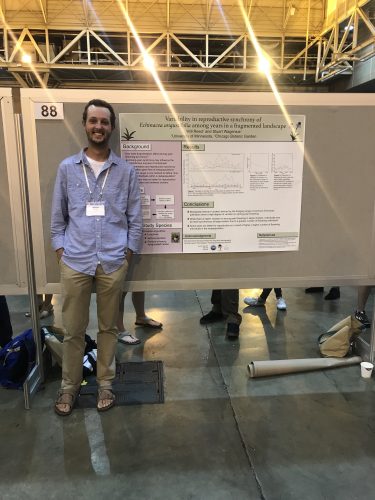|
|
Next up from MEEC we have Riley’s poster about the photosynthetic rates of Hybrid plants in exPt7. Riley collected the data for this project in the summer of 2018, and has been working on aggregating and analyzing since then. The central question behind the research: do Echinacea hybrids between E. angustifolia and E pallida have higher photosynthetic rates than conspecifics?
 Riley with his poster Overall (as the title says), Riley found that E. angustifolia may be in trouble if it has to compete with E. pallida. Both the hybrids and conspecific E. pallida plants were more photosynthetically active than E. angustifolia. Additionally, they had higher survival rates. And to put the final nail in the coffin, the only plant that has flowered in exPt7 is an E. pallida plant. All things considered, Riley’s work is crucial to finding out how to protect E. angustifolia from this invasive species!
Click the link bel0w for a full .pdf of Riley’s Poster
echinaceaPoster2_Thoen
Title: Native Echinacea angustifolia has depressed viability relative to non-native E. pallida and reciprocal hybrids (E. angustifolia x E. pallida) in a fragmented prairie habitat
Presented at: MEEC 2019 at Indiana State University in Terre Haute, IN
When: April 27th, 2019
Hello Flog!
Over the next few days, I’ll be making a few posts about the various Team Echinacea members who attended MEEC (Midwest Evolution and Ecology Conference) 2019. This conference was hosted by the grad students of Indiana State University at Terre Haute from April 26th to 28th. Six members of Team Echinacea attended: Evan, Kristen, Mia, Michael, Riley, and Tris. Everyone made a poster, execpt for Kristen who gave an excellent talk about her research on ground nesting bees.
In this first post, I wanted to highlight Evan’s poster about the echinacea pollen bank. This was work the he and Zeke did in P2 this summer, and is the basis of Zeke’s senior independent study at Wooster College. Evan, and another member of the Ison lab at Wooster, Nate, presented the poster summarizing this work at MEEC. They had by far the most attractive drawing of native bees of any poster present. You can read all about the pollen bank project on the background page for the experiment!
 Evan with his MEEC poster Title: Specialist pollinator Andrena rudbeckiae removes more Echinacea angustifolia pollen per visit than more generalist bee taxa
Presented at: MEEC 2019 at Indiana State University in Terre Haute, IN
When: April 27th, 2019
Poster Link: Evan Jackson Midwest Ecology and Evolution Conference (MEEC) Poster
Hello again!
I’m back with more updates from our team trip to Terre Haute for MEEC 2019. Today, I want to show off the incredible pollen limitation study poster presented by Tris Dodge. Tris joined Team echinacea this last November when he was a Carleton Extern at the Chicago Botanic Garden for three weeks before winter break. As an intern, Tris did a lot of work gathering and analyzing data on our pollen limitation study. If you want to learn more about that study, check out our background page. If you want to see the work that Tris did specifically, check out the flog posts that he has written. Tris’s flog posts include a direct link to his poster
In his analysis, Tris found out that creating seeds is basically free for echinacea plants. If they produce a lot of seeds one year, they can produce a lot of seeds the next year as well. This was not what we had predicted! Tris used the data from 7 years of the pollen limitation study to show that plants that had zero reproduction did not turn into big-leafed, multi-head super plants, but instead look exactly the same as those heads that produced many achenes.
 Tris presenting his poster to Nate Title: Little cost of reproduction in the long lived perennial, Echinacea angustifolia
Presented at: MEEC 2019 at Indiana State University in Terre Haute, IN
When: April 27th, 2019
Hello once again flog!
Last weekend I presented a poster (link below) at the Massachusetts Association of Conservation Commissions convention in Worcester, MA.
This was my first poster symposium and I am glad to say it went great! I was able to interact with so many people attending the conference, along with other student researchers. I received some wonderful comments and feedback, and hopefully was able to make more people aware of soil, native bees, and the Echinacea Project!
My poster focused on the soil texture data I collected over January and its correlation to native bee nesting. After a little more work in R, I found some surprising results. The percent of sand or silt did not have any influence on bee presence. However, between the eight sites and the three land uses, variation in percent sand was significant. Meaning, soil variation does exist across the Echinacea Project sampling area, it just might not be the strongest factor influencing bee nesting.
The soil is only one component of this project though. We also collected data on the slope, vegetation, percent bare ground, and soil hardness. One of these variables may be the key in understanding native bee nesting, so there’s a lot more analyzing and R to come.
I am so grateful for all the help I have received to make my first poster experience a success!
Until next time!
 Click on the link below to see a high resolution image of the poster annavoldMACCposter19Final
After processing soil samples for two weeks (341 to be exact!) I was able to analyze some of the results and, along with the trusty functions of R (and of course T-Swift music) graph my data. I have included my poster down below and a pdf link.
The results provide evidence that shows soil in western Minnesota contains large percentages of sand and silt, with little clay. Between each of the 8 locations, some variation was present in the amount of sand, but not with clay. The results also showed that sand and silt may have no influence on the nesting locations of native bees. When compared, the graphs of sand and silt percentages from where a bee was found and not found were quite similar. So the question remains- What are the factors that influence where bees build their nests?
Throughout my entire time working on Team Echinacea and this soil project, I have gained valuable knowledge and experience about data collection, project development, and different research methods. And not to mention the amazing lab group and individuals I have gotten to work/collaborate with! Since my college career is just beginning, the future has a lot in store for me- I can’t wait to see what happens in the next couple of years.
But one thing is for sure, I can officially cross “eat deep dish pizza in Chicago” off my bucket list!

AnnaVoldposter19.pdf
Hi flog,
Wow! These last three weeks passed by super quickly! While the first two weeks were focused on seed cleaning, seed counting, and x-raying, we spent this past week on our independent projects. But that’s not to say this week was easy! In the past 5 days, I wrote exactly 900 lines of code in R to generate the figures and perform the analyses.
To get at how current pollen limitation affects Echinacea growth and future fitness, I performed analyses testing differences in plant traits between pollen exclusion, pollen addition, and open pollination treatments. I did not find evidence that pollination treatment affected either growth or fitness, which indicates that current pollen limitation will not benefit Echinacea in the future. This could be because Echinacea is not resource limited or because the cost of seed production is negligible.
Many thanks to the members of Team Echinacea who helped guide me through this process and made working in the lab such a pleasure!

Tris
Link to Poster
 The aphids were a hit at Carleton’s Summer Research Symposium. At the Carleton College Summer Research Symposium on October 26th, I presented a poster on my work on the aphid addition/exclusion experiment. Over the summer, I administered the aphid addition and exclusion treatments for the experiment and collected data on leaf senescence and herbivory on plants in the study. Since August, I have been developing an aster model in R to analyze differences in fitness between these two experimental groups. Preparing the aster model for my project was quite a bit of work, but I learned more about R, statistical analysis, and plant-herbivore interactions in the process. Interestingly, Aphis echinaceae has not had an impact on plant fitness over the 8 years of the study.
I am excited to see how the experiment progresses in the coming years, and how the addition of data on seed set affects the results of future fitness models. Quite a few visitors to the symposium were also interested in the results of my analysis and my experience working with the aphids. It was a pleasure to represent the Echinacea Project at Carleton and to have a chance to share the fantastic work the team did over the summer.
Hello Echinacea folks! After a great summer at the Echinacea Project, I returned to Gustavus to work on the morphological and physiological data I collected at experimental plot 7. In my time at Gustavus so far, I wrote a proposal for my project so I can analyze my data and undertake a senior honors project under familiar Echinacea advisors Pamela Kittelson, Stuart Wagenius, and Sanjive Qazi. I have also worked on a methods section for my final honors paper and made a poster (attached below). In addition to my project, this fall I have been working on a project to implement composting and sustainable practices in Saint Peter restaurants and a project analyzing microRNA-mediated stress response in smooth cordgrass. The next steps for my honors project are to write up an introduction and do statistical analysis over our January-term. I will be performing aster and cluster analyses and am really excited to get back into some R coding! echinaceaPoster1_Thoen
Last week, I attended ESA for the first time and presented a poster on a project I’ve been working on for the past few months: how the synchrony of flowering phenology within clusters of Echinacea depends on the connection distance used to define those clusters. I presented on Tuesday, August 7, 2018 in PS 18: Habitat Structure, Fragmentation, Connectivity from 4:30-6:30, board #92 (just feet away from Will’s poster). My main results are that clusters of Echinacea defined by a small connection distance tend to have lower synchrony on average than clusters defined by larger connection distances. Clusters defined by smaller connection distances also have more variation in synchrony. In terms of a bee’s perspective, this could mean that bees with smaller foraging distances are experiencing more synchronous clusters of Echinacea as they travel from one plant to the next. However, the experience from one small bee to the next is variable. Larger bees with larger foraging distances might be experiencing clusters that are more asynchronous, so as they travel from one Echinacea to the next, plant flowering times might not be overlapping as much.
There was an almost continuous flux of people coming by, and even though I was nervous at first, these couple of hours were probably my favorite part of the conference. Even if some of the listeners didn’t ask me specific questions at the end, just describing my project over and over made me realize what parts I wanted to continue thinking about and working on. I had scientists come by that I recognized from talks I had seen, Team Echinacea alumni interested in what we are doing now, and people I didn’t know that just came because of the title! It was all really exciting and I have a page of notes with questions and ideas to think about as I move forward with this project.
The conference as a whole was a really great experience for me, because I could start to see how both this specific project and my general interests fit in with the rest of the ecology world. It helped me to start to define the questions I want to ask as I think about grad school and the future.
 Tracie and her poster at ESA 2018 🙂 Stay posted for more updates on this clusters project!
Link to PDF of Tracie’s ESA poster
Hello from New Orleans!
Yesterday I presented my poster on the general patterns of Echinacea flowering in our study area! I found that there are patterns of high and low flowering across all of the remnants that we study. I also found that there are good years to flower for the metapopulation that we study (and bad years..). What could be causing lots of echinacea to flower in the same year?
I presented my poster at Poster Session 18 – “Habitat Structure, Fragmentation, Connectivity” from 4:30-6:30. I had lots of visitors stop by to hear about my results and got to meet several Echinacea Project Alums!
 Me and my poster <3 Here is my poster:
Wills ESA Poster PDF
|
|

